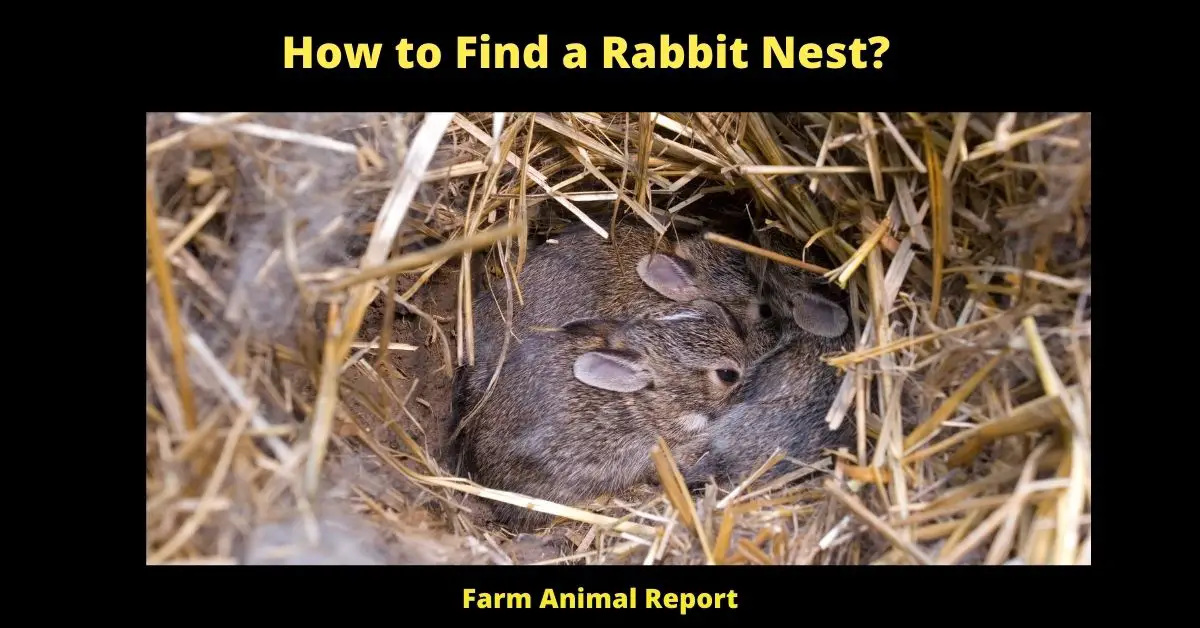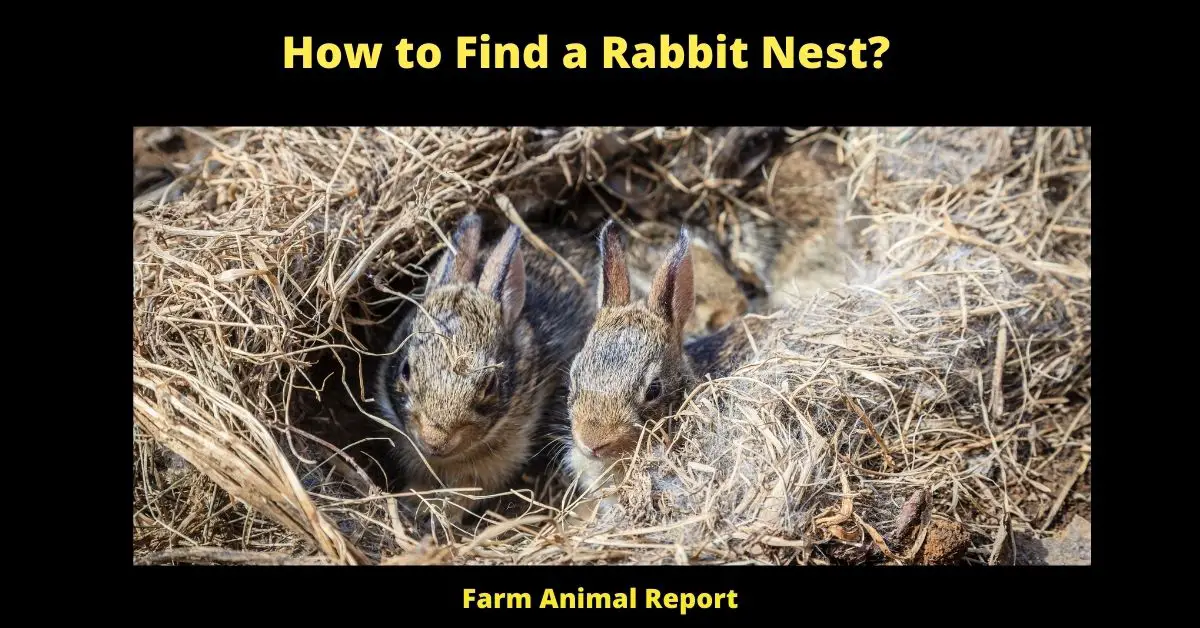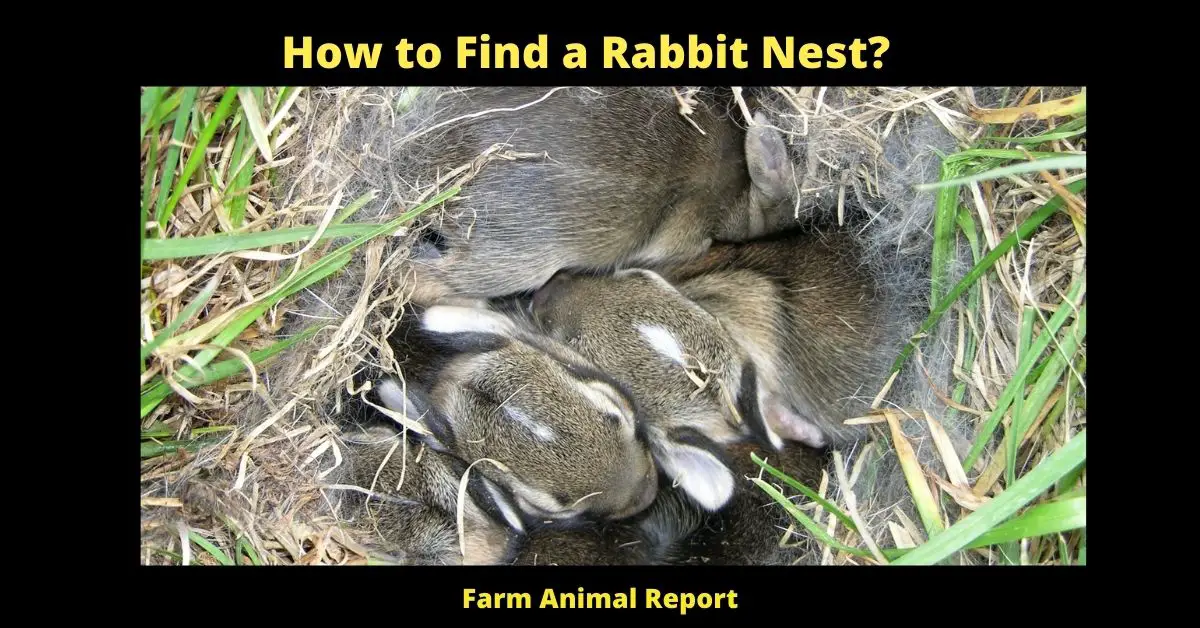How to find a Rabbit Nest – As a general rule Rabbit nests in home yards are generally extremely effectively camouflaged amid the lawns – they appear to be nothing more than patches of dead grass on the surface. Rabbits will build a shallow nest of grass and fur in grassy areas near bushes or trees and often right out in the open.
These nests tend to look like patches of dead grass, or dead spots, in your yard. Underneath these patches will be the babies, called kittens A rabbit’s Nest may be distinguished from other types of nests by its common framework of grass and fur.
Tallgrass is firmly braided into clumps of the mother’s fur, which serves as insulation and concealment for the animal. This protects the burrow beneath the surface
How to Find a Rabbit Nest?
Everything comes to life in the springtime — the sun is shining, the grass in our gardens has finally grown to a healthy height, and small bunnies are peeking out of their nests. With this in mind, most of us are curious about finding a rabbit nest while mowing our lawn. How to Find a Rabbit Nest?
Rabbits’ nests are often well hidden and can be found in various locations. A rabbit’s Nest may be distinguished from other types of nests by its common framework of grass and fur. Tallgrass is firmly braided into clumps of the mother’s fur, which serves as insulation and concealment for the animal. This protects the burrow beneath the surface.
Jump To 18 Ways to Make Money by Rabbit Farming **CHARTS**
Rabbit nests in home yards are generally extremely effectively camouflaged amid the lawns – they appear to be nothing more than patches of dead grass on the surface, but beneath them are clusters of young bunnies waiting for their mother to return and feed them. Before mowing the grass, it is vital to be aware of how subtle a rabbit’s Nest seems and examine the lawn for any signs of activity.

Don’t open the cover to reveal the adorable rabbits hidden inside. Newborn bunnies are wonderfully adorable and entertaining to watch but don’t allow this to put them at risk for extinction. Please do not touch the Nest even if nothing appears.
Where Do Rabbits Nest?
The most prevalent rabbits’ nests are those close to shrubs, trees, and long grass.
Finding a rabbit nest full of baby rabbits but with no sign of an adult, rabbit is not an emergency condition. Mother rabbits remain gone from their nests for the majority of the day, only returning to feed their young a handful of times during the day. In most cases, if the infants are developing and being fed properly, it is preferable just to leave them in their current location to be cared for by their mother and, when they are old enough, to venture outside and experience the world on their own.
If you ever come across an injured wild animal, it’s always advisable to get professional advice before intervening.
Should I Move a Nest of Baby Rabbits? Nest – Mother
If you come upon a nest that has been disturbed, have a look at the babies before moving it. It is best if you do not move the Nest because small bunnies may be physically damaged due to their fragile body. Leave the infants alone and cover the Nest with a blanket.
The absence of the mother rabbit may lead some well-meaning individuals to believe that a nest has been abandoned, although this is most likely not true. Mama rabbits are astute and only visit their nests when absolutely necessary in order to avoid drawing attention to them. In all likelihood, the mother is someplace nearby and will return when it is time for the infants to be fed or nourished, which is normally in the mornings or the evenings.
And don’t be alarmed if you or your child comes into contact with the bunnies. According to popular belief, a mother rabbit (as well as many other animal mothers) would reject her kids if they have a human odor on their bodies. Cover the rabbit’s Nest and don’t touch the babies again; touching the infants might harm and stress everyone involved.
Jump to How Long Can a Rabbit Go Without Eating?
What Can I Do to Assist the Baby Rabbits in Need?
- Before you mow your grass, take a look around your yard. It’s not uncommon for people to come upon nests when performing yard chores in the yard.
- If you come upon a nest, mark the location somehow to locate it later. Placing a marker flag or tiny placard in the ground near the Nest for identification is a good method.
- If you have curious dogs or small children, consider building a temporary plastic fence around the Nest. This item may be purchased at your local home improvement retailer. Simply ensure that there are openings wide enough for the mom rabbit to pass through but small enough to keep dogs and children out.
Jump to Baby Rabbits **WATCH**
Wild Rabbit Nesting Behavior
It is common for wild rabbit moms to spend little time with their offspring in their nests as a strategy of remaining unnoticed and preventing prospective predators from taking attention. They only come to their nests twice a day, once at the start of the day and again at the end of the day. Feeding of the young children takes place throughout those hours. Because the mothers are rarely present with their babies at their nests, it is frequently difficult to determine whether or not a litter has received parental care in general. Most of the time, the rabbit’s mother is present — babies are simply waiting for her to arrive. On other occasions, the litter might be left without a mother if she died or, in certain cases, abandoned them.
How do Wild Rabbit Nest Building?
The female Wild rabbit searches for a safe, secluded location for construction. She will build Nest in multiple places including, depression in the ground, behind a log or a bush, in a crack between rocks, inside a depression in a field, or another open place. If she can locate a suitable location, she will make one by scratching in the ground until she creates a space that is 5 to 7 inches long and 4 to 7 inches deep.
A wild doe constructs her Nest out of whatever soft materials she may find around her territory. A significant amount of grass is often present in the lining of wild rabbits’ nests. Other items, like leaves, small roots, and even fragments of paper or other rubbish, may be added to the lining of the Nest by the mother. When she is about to give birth, she will pluck soft fur from her bottom and use it to line the inside of the Nest as an inner lining.
How Long do Baby Rabbits Stay in the Nest?
Bunnies will stay in the Nest for almost three weeks. After that, they leave when they are old, roughly the size of a chipmunk. If you come across a rabbit of this size with ears upright, eyes open, and the capacity to hop, it is likely that they were supposed to be left on their own. They are not an orphan and do not require your assistance, despite their appearance of being little and defenseless.
Facts About Rabbits
- You may avoid causing injury to newborn bunnies by thoroughly inspecting your yard for bunny nests before you start mowing in your lawn. This is especially important if you’ve allowed your lawn grass to grow longer than required.
- Pets, especially cats and dogs, pose a serious threat to rabbits’ well-being. Suppose your dog/cat manages to catch a rabbit. In that case, the affected rabbit should be sent to a qualified wildlife rehabilitator or veterinarian as soon as possible for a general check-up. After that, stop your dog/cat from going outside again because they will remember where the Nest is, putting the other rabbits at risk of being attacked by them.
- Also, unfortunately, it is fairly unusual for individuals to leave their pet bunnies outside. Domestic rabbits have a distinct appearance that differs from that of wild rabbits. Cottontail rabbits, which are brown with whitetails, make up the majority of wild rabbits in the United States. Domestic rabbits can weigh anything from 2 to 20 lbs. These animals have ears that are either raised, drooping, or stuck in the middle. For example, they have a broad range of colors and patterns on their coats; they may be as simple as pure white/albino to as complex as pure black, with various greys and browns in between; their patterns can be spotted, striped, or odd.
Do Rabbits re-use their Nest?
No, they do not. The baby bunnies will not mate until they are around six months old, and they will construct their own Nest in the meanwhile. Unlike the female, they will not re-use the nests that she built.
What should I do if I find an Empty Rabbit Nest?
The best thing you can do is leave the Nest alone and avoid disturbing it as much as possible. Rabbit’s mother is most likely not going to be around in the immediate vicinity; she’s generally hiding somewhere and hoping you’ll leave her Nest alone.

How Deep are Rabbit Nests
Rabbits are small mammals that are found in many parts of the world. They are known for their long ears and furry tails, and they are often used as pets or as livestock. Rabbits are also popular as a source of food, and their meat is considered to be very lean and healthy.
Interestingly, rabbits are also able to dig deep burrows in which they live. These burrows can be up to 10 feet deep, and they often have multiple entrances and chambers.
The main chamber is typically where the rabbit sleeps, while the other chambers are used for storing food or for raising young. Rabbit nests are typically lined with soft materials such as grass or fur, and they provide the animals with a safe place to live.
What to do if you find a Bunny Nest
It’s early spring, and you’re out for a walk in the woods when you see something small and round out of the corner of your eye. As you get closer, you realize it’s a nest full of baby rabbits! You may be wondering what to do next. Here are some tips from a experienced rabbit farmer.
First, resist the urge to handle the rabbits. Baby rabbits are delicate, and they can easily be injured by handling. If you must move them, use a soft cloth or your hands cupped together to scoot them gently into a box or onto a towel.
Second, find out if the mother rabbit is nearby. Mother rabbits will only visit their nests a few times a day to feed their young, so she may not be around when you find the nest. If possible, try to find her and put the nest back where you found it before she returns. If you can’t find the mother rabbit, or if she doesn’t return within 12 hours, you can contact a wildlife rehabilitator for help.
Third, keep pets and children away from the nest. Pets and children can be too rough with baby rabbits, and they may unintentionally injure them. If you have pets, keep them inside or leashed until the baby rabbits are gone. And make sure your children know not to touch the rabbits without your permission.
Finding a bunny nest can be a fun discovery for kids and adults alike. By following these simple guidelines, you can help ensure that these precious little creatures will stay safe until they’re ready to venture out into the world on their own.
What is a Rabbit Nest Called
. The word “Warren” is often used to describe a group of rabbits living together in close quarters, such as in a commercial rabbitry. It can also be used to refer to an area where wild rabbits live in high densities, such as on a nature reserve.
What is Rabbit Nest Fur Purpose
A rabbit nest is a structure built by a rabbit to lined with soft materials such as fur and grass in order to provide a comfortable area for the doe to raise her litter. The nest is usually located in a burrow, but may also be constructed above ground in dense vegetation
. A doe will typically build several nests during the breeding season, and will use them interchangeably depending on her needs at the time. For example, she may choose to move her litter to a new nest if the first one becomes soiled or if predators are threatening the area
Final Thoughts: How to Find a Rabbit Nest?
The most prevalent locations of rabbits’ nests are those that are close to shrubs, trees, and long grass. The lifespan of a baby bunny is relatively short (they are normally independent at approximately three weeks of age), so you won’t have to worry about avoiding it for an extended period of time. People frequently encounter rabbit nests due to their pet dog smelling them out or when wandering around the yard mowing their lawn. If possible, refrain from moving around the Nest and keep your dog on a leash outdoors so that they don’t dig up the young bunnies for at least three weeks.





